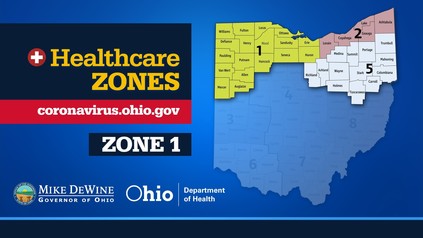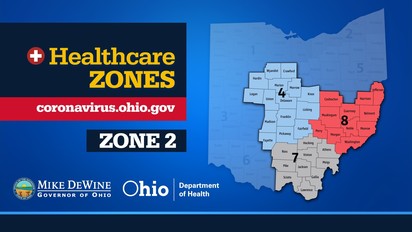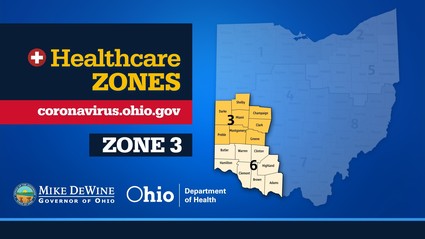FOR IMMEDIATE RELEASE:
November 9, 2020 |
MEDIA CONTACTS:
Dan Tierney: 614-644-0957
Breann Almos: 614-644-0957
|
COVID-19 Update:
Unprecedented Spike in Hospital Admissions
(COLUMBUS, Ohio)? This afternoon, Governor DeWine was joined by incoming Ohio Department of Health Chief Medical Officer Dr. Bruce Vanderhoff and leaders of the Ohio Hospital Association to discuss the status of hospital capacity in Ohio as the number of COVID-19 cases continues to surge throughout the state.
There are currently over 2,500 hospitalizations statewide, up from 2,000 hospitalizations on Thursday. A total of 154 hospitalizations were reported in the last 24 hours alone.
"In Ohio, we are seeing an unprecedented spike in hospital utilization and it is impacting all areas of the state. While we are better prepared with personal protective equipment and physical capacity, what we are seeing now is an increasing demand on our staffing," said Dr. Vanderhoff. "If we don't control the spread of this virus, we won't be able to care for those who are acutely ill without postponing important, but less urgent, care. We anticipate that this kind of shift could happen in a matter of weeks if trends don't change."
?The COVID-19 pandemic is becoming more dire for Ohio as hospitalizations have escalated 350 percent in the past 50 days to 2,533 COVID patients in Ohio hospitals today,? said Mike Abrams, president and CEO, Ohio Hospital Association. ?Our hospitals are capable of managing capacity needs, but we must stem the spread now. This steep climb creates a severe strain on our caregivers who are braving the frontline of this pandemic. We can stop this spread, and we call on Ohioans to join hospitals and caregivers to take action now and do the right thing to slow the spread.?
At the beginning of the pandemic, Governor DeWine worked with the Ohio Hospital Association to develop a comprehensive statewide public health system to ensure that all Ohioans have access to quality care during the pandemic. As part of this process, the state was divided into three healthcare zones. Leaders of each zone provided an update on hospital capacity in their regions.?

ZONE 1
Of all hospitalizations in the state, more than 50 percent are in Zone 1, but there are currently enough hospital beds, personal protective equipment (PPE), medication, and ventilators. Total beds utilized and intensive care beds utilized in Zone 1 currently stands at 70 to 75 percent. This zone, however, is seeing many caregivers becoming ill with COVID-19. At the Cleveland Clinic alone, there are currently 300 caregivers out due to the coronavirus.?
"It's not because they're catching COVID in the hospital. What we're seeing is they're catching it in the community," said Robert Wyllie, MD, of the Cleveland Clinic. "What we're asking everyone to do is double down. Now is the time to wear a mask and socially distance - if not to protect your family and friends, do it to protect the caregivers who protect COVID patients and other hospitalized patients."
|

ZONE 2
Last Monday, Zone 2 hit a milestone of 400 patients in the hospital, and by Friday, the number surpassed 500 patients. Today there are over 560 COVID-19 patients hospitalized with COVID-19 in Zone 2.
Because patients are normally admitted 7 to 14 days after symptoms arise, hospitals are expecting to see hospitalizations continue to increase for at least two weeks after COVID-19 cases peak which could impact non-COVID care.
"We need the citizens of Ohio do to the same things they did in the spring and summer - take seriously masking, distancing, washing hands, and especially avoiding large gatherings of people you don't live with where you can't control your environment and you can't protect yourself or loved ones from someone in that crowd who is asymptomatic positive," said Andrew Thomas, MD, MBA, of The Ohio State University Wexner Medical Center.
|

ZONE 3
Zone 3 has had an unprecedented increase in COVID-19 hospitalizations since the beginning of October. There are over 670 patients hospitalized today, as compared to 300 patients at the peak of the previous surge in July. In the greater-Cincinnati area, the positivity rate had been approximately 3 percent but is now standing at approximately 8 percent.?
In Zone 3, the growth of hospitalizations is doubling every three weeks. Right now, Zone 3 can accommodate the current capacity of patients, but if the doubling of cases continues to accelerate, this zone could exhaust resources and may have to defer non-COVID care.?
"If we do what we did in the past - adhering to social distancing, wearing a mask, washing hands, and not expanding your personal bubble, we can bring the spread of this virus under control," said?Richard Lofgren, MD, MPH, FACP, and president and CEO of UC Health.
RURAL HOSPITALS
Ronda Lehman, president of Mercy Health, Lima region, also discussed the hospital capacity in their hospital system, which encompasses many rural communities. There is currently adequate capacity of PPE, ventilators, and hospital beds, however, hospitalizations are increasing. On October 5, the hospital system had 17 COVID-19 patients, and today they are treating 75 patients who are COVID-19 positive.
"This is a stark challenge for us because this is in addition to the normal fall flu and critical illness admissions, and it's not sustainable," said Lehman. "This is not a metro problem, this is a statewide and countrywide problem. Those in small communities should recognize that their behaviors do have a substantial impact to their neighbors, their local hospitals, the people they worship with, the people they go to school with, and the people they care about in their circles."
CURRENT CASE DATA
In total, there are 254,974 confirmed and probable cases of COVID-19 reported in Ohio and 5,524 confirmed and probable COVID-19 deaths. A total of 20,651 people have been hospitalized throughout the pandemic, including 4,047 admissions to intensive care units.?In-depth data can be accessed by visiting coronavirus.ohio.gov.?
Video of today's full update, including versions with foreign language translation, can be viewed on the?Ohio Channel's YouTube page.?
For more information on Ohio's response to COVID-19, visit?coronavirus.ohio.gov?or call 1-833-4-ASK-ODH.
|
|
